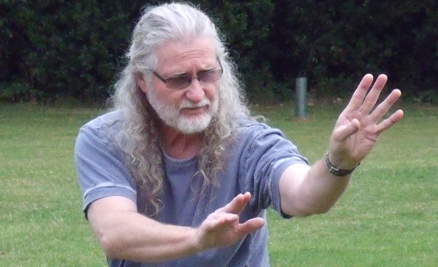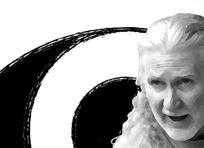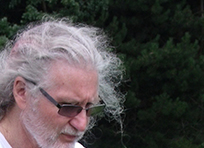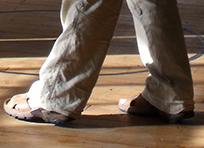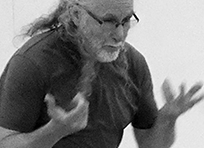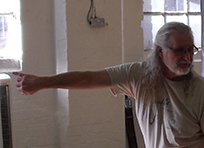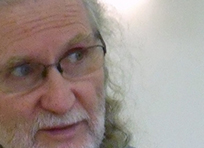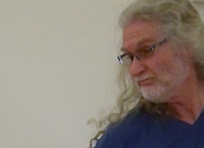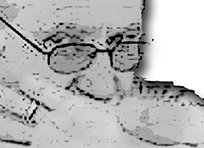Erle had been practicing the internal arts since 1968 and could trace his lineage directly back to Yang Lu-ch’an, the founder of the Yang Style. Erle had taught and given workshops all around the world from his native Australia to the
United Kingdom, Europe, America and the Far East. In fact, he was one of a select few Westerners who has taught Taiji back to the Chinese!
As explosive and forthright in his views as his art and as eclectic and colourful as his teachings, Erle was no stranger to controversy. In fact since the early 80’s he had been a lone voice, swimming against the tide as it were, of modern Taiji practitioners - specifically with his introduction of Yang Lu-ch’an’s original explosive form into the public domain of modern Taijiquan.
Erle began his martial arts instruction at the age of 11, training in karate and judo at the local Police Boys’ Club in Australia, as well as wrestling, which later led to a stint as a professional wrestler!
In 1967, whilst taking a telephone maintenance course, Erle met his first teacher of Taijiquan, Mr. Wong Eog. People would mistakenly call him “Tokyo Joe," thinking he was Japanese! The style Erle learned from Mr Wong turned out to be Dong’s fast form - for some time he mistakenly thought that this was the older version of Yang family Taiji - developed by Dong Yingjie, the disciple of Yang Cheng-fu.
In 1974, during a three-year stint in England, Erle met his second Taijiquan instructor, Mr. Chu King-hung – one of only three disciples of the late Yang Shouzhong, the eldest son of Yang Lu-chan’s grandson, Yang Cheng-fu. It was Chu who first introduced Taiji as a fighting art to Erle and this would arouse his curiosity to seek why the art was called “supreme ultimate boxing”? Chu would also teach Erle “the tricks that were supposed to be a result of some mystical or magical hidden force but in reality were nothing more than deceptive tricks or entertainment.”
It was only when Erle started to test himself against other martial artists and styles that he realised that all his training did not translate into instant success, after being knocked down by a Kenpo practitioner! This would force Erle to turn towards the stories and training methods of the older Masters, thus beginning his long research into the origins of Taijiquan. Upon his return back to his native Australia, Erle began corresponding with Yang Shouzhong personally, who would write back via an interpreter. Erle would ask important questions relating to the exact nature of how the classical postures ought to be done and Yang Shouzhong would respond accordingly.
Erle, meanwhile had started working as a chauffeur in Sydney and would often stop by the docks to practice his Taiji. It was here, one day in 1978, that he saw an old man doing something that looked like Taiji but Erle could not be sure. In his own words, Erle tells us: “Eventually, I plucked up enough courage to get out of the limo and watch, he would not even acknowledge that I was there, not even when I did my own Taiji form in my chauffeur's outfit would he even look. After many months I was able to gain his attention by performing some faster forms and this aroused the ego that was still left in him. I then discovered that he was one of only three students of the Grandson of the founder of the Yang style Taiji, YangShou-hou.”
This was Chang Yiu-chun and he would go on to become Erle’s main internal arts teacher. Erle would spend the next 5 years watching and learning from Chang. The information he gleaned from Chang would change his perception of what Taijiquan was really about forever. Erle kept diligent notes of his training with Chang. The notes were always full of questions and over time, Erle learned to put his questions more precisely as Chang’s English was poor and so that he “would not end up in great pain," from Chang’s demonstrations! It was Chang who taught Erle all about the ‘Old’ Yang style or H’ao Ch’uan. It was Chang who taught him the secrets of Dim-Mak and the fighting and training methods of Shou-hou’s system.
In 1983, Chang parted company with Erle with the following words: “No need me.” He would never return to their training spot again. Erle found out that he had headed back to China. Perhaps the old man knew or sensed something and wished to return back to the old country for sentimental reasons. A few years later, Erle finally received confirmation - his teacher had passed away in 1986.
In 1981 Erle traveled to Hong Kong, where his form was evaluated by Yang Sau-chung and where he studied with Ho Ho-choy, a direct disciple of Baguazhang Master Chiang Jung-jiao. In 1982, he began teaching Taiji in Sydney and became the chief of therapeutic movement at the NSW College of Natural Therapies. He opened his own school in Sydney in 1983.
In 1985, Erle became the first Westerner to perform at the All China National Wushu Tournament, held in Yinchuan (Giang-Nan), Ningxia Province, China, at which time he was tested for hours by three of the world's leading internal martial arts experts and received the degree of Master. He is believed to be the only Westerner to have earned such an honour.
Also in 1985, Erle again traveled to China having been accepted after nine years of negotiations, to train with the famous master Liang Shih-kan, the leader of the original Internal system called Wudang Shan. Erle is the first Westerner to have ever learnt the 9 (12) Qi Disruptive forms, said to be the precursor of all the internal martial systems.
In his “spare time," Erle wrote his own column for several prestigious martial arts magazines, as well as serving as the editor of “Combat & Healing” – a widely read and highly regarded magazine discussing the internal arts.
Between the years of 1979 and 2011, Erle had an explosion of creativity and production and had produced the largest number of DVD titles on the internal fighting/healing arts as well as a wealth of books published world-wide. He became the first Westerner to introduce Dim-Mak to the Western World with his books from the early 80's and also DVD productions. Many students have learned from these quality tapes in lieu of a teacher in what today is regarded as the “Erle Montaigue System” or as he liked to call it, “Moving to survive!”
Never the “Master” and always simply Erle to his students and friends alike, he was never as happy as when he was talking about his family and music. Sadly, Erle passed away suddenly on January 26, 2011 whilst out walking with his family,
near his home, next to the Black Mountains, in Llangadog, Wales, UK.
Erle Montaigue
An Introduction to the Founder

